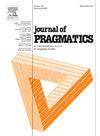英语口语中now作为语篇标记的最新变化
IF 1.7
1区 文学
0 LANGUAGE & LINGUISTICS
引用次数: 0
摘要
本研究使用来自20世纪90年代和2010年代编制的两个不同语料库的数据,考察了now在英语口语中的演变作用。对随机选择的标记进行分析,将now的出现区分为时间副词或话语标记(DM),重点关注位置模式、社会因素(年龄和性别)、功能分布以及与其他DM的共现。研究结果显示,虽然现在DM主要出现在回合或话语起始位置,但它在话语中间位置的出现明显增加,反映了更广泛的语用发展。如今,公文语越来越多地用于文本和情感功能,如转移话题、标记对比或指示立场,而不仅仅是指代时间。从使用者的人口统计来看,现在DM使用量的增长主要是由年轻的使用者推动的,这表明与20年前相比,这是一代人的转变;然而,性别对总体频率没有显著影响。DM共现的分析表明,加性模式是最常见的,而组合和并列的形式是不常见的。总的来说,这些结果强调了现代英语中now的多功能性,反映了话语结构、互动管理和代际语言转换的更广泛趋势。本文章由计算机程序翻译,如有差异,请以英文原文为准。
Recent changes of now as a discourse marker in spoken English
This study examines the evolving role of now in spoken English using data from two distinct corpora complied in the 1990s and 2010s. Analyses of randomly selected tokens distinguish occurrences of now as either a temporal adverb or a discourse marker (DM), with a focus on positional patterns, social factors (age and gender), functional distribution, and co-occurrences with other DMs. Findings reveal that while the DM now predominantly appears in turn- or utterance-initial positions, its occurrence in utterance-medial positions has notably increased, reflecting broader pragmatic development. The DM now is increasingly used for textual and affective functions, such as shifting topics, marking contrasts, or indicating stance, beyond its time-referential role. In terms of speaker demographics, the rise in DM now usage is largely driven by younger speakers, indicating a generational shift from two decades earlier; gender, however, does not significantly affect overall frequency. Analysis of DM co-occurrences shows that additive patterns are most frequent, whereas compositional and juxtaposed forms are less common. Overall, these results underscore the growing versatility of now in contemporary English, reflecting broader trends in discourse structuring, interaction management, and generational language shift.
求助全文
通过发布文献求助,成功后即可免费获取论文全文。
去求助
来源期刊

Journal of Pragmatics
Multiple-
CiteScore
3.90
自引率
18.80%
发文量
219
期刊介绍:
Since 1977, the Journal of Pragmatics has provided a forum for bringing together a wide range of research in pragmatics, including cognitive pragmatics, corpus pragmatics, experimental pragmatics, historical pragmatics, interpersonal pragmatics, multimodal pragmatics, sociopragmatics, theoretical pragmatics and related fields. Our aim is to publish innovative pragmatic scholarship from all perspectives, which contributes to theories of how speakers produce and interpret language in different contexts drawing on attested data from a wide range of languages/cultures in different parts of the world. The Journal of Pragmatics also encourages work that uses attested language data to explore the relationship between pragmatics and neighbouring research areas such as semantics, discourse analysis, conversation analysis and ethnomethodology, interactional linguistics, sociolinguistics, linguistic anthropology, media studies, psychology, sociology, and the philosophy of language. Alongside full-length articles, discussion notes and book reviews, the journal welcomes proposals for high quality special issues in all areas of pragmatics which make a significant contribution to a topical or developing area at the cutting-edge of research.
 求助内容:
求助内容: 应助结果提醒方式:
应助结果提醒方式:


